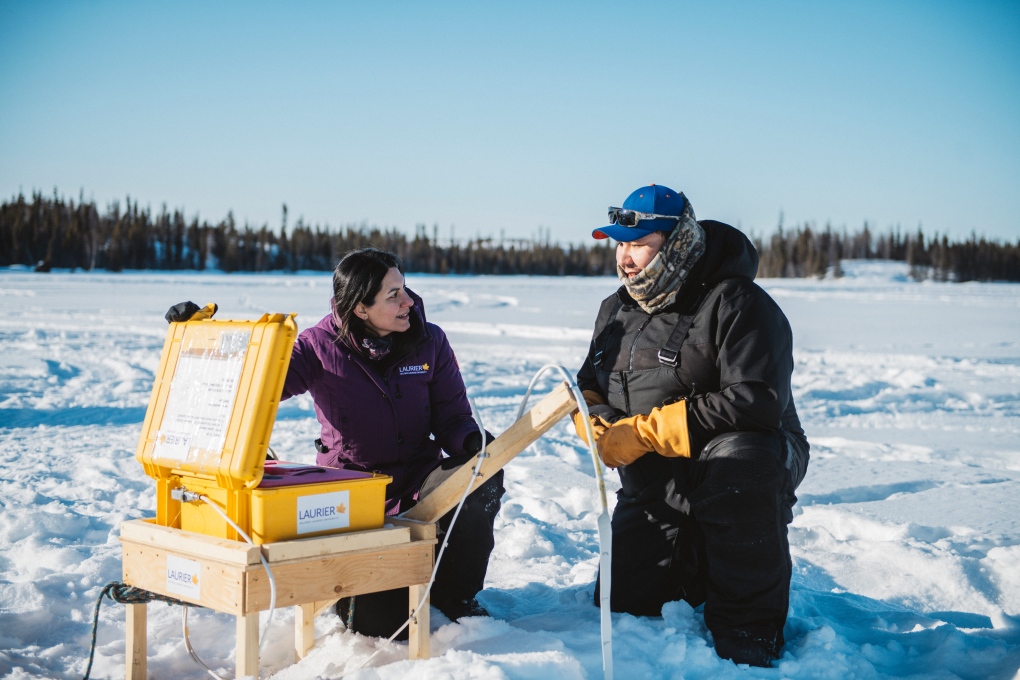How a Wilfrid Laurier researcher is using advanced technology to improve ice roads
A Wilfrid Laurier researcher is using advanced technology to better understand ice roads in Canada’s far north.
Canada Research Chair in Remote Sensing of Environmental Change Homa Kheyrollah Pour has worked with the community of Délı̨nę, N.W.T. for the last few years to help monitor the ice roads the region rely on.
“I would know how much ice actually grew last night, because the sensor will send this to us. These sensors can be installed in a remote area that you don’t have to be there to measure it,” Kheyrollah Pour said.
No highway infrastructure exists around Délı̨nę, so the majority of supplies cannot be brought in during the summer. Most supplies are delivered in the winter, using ice roads that play an extremely important role for resupply. Around 80 to 100 vehicles a day use the connections.
“That kind of real time information is helpful to us in terms of planning additional profiles to measure the ice thickness, and determining how fast ice grows over an identified period,” Dustin Dewar, regional highway manager, Dehcho & Sahtu Regions, Government of Northwest Territories, said.
 Homa Kheyrollah Pour has been working with the community of Délı̨nę, N.W.T. for the last few years to monitor ice roads in the region. (Wilfrid Laurier University)
Homa Kheyrollah Pour has been working with the community of Délı̨nę, N.W.T. for the last few years to monitor ice roads in the region. (Wilfrid Laurier University)
Traditional knowledge has be used for years to help build these ice roads, but now with research using ground-penetrating radar systems, drones and satellites, it helps determine when weight limits can be increased for a safer and more efficient approach.
“In the past we would use general rules of thumb to estimate approximately when we would be taking the next profile, but having this real time information it’s very helpful in planning,” Dewar said.
While each ice road is different, researchers say the technology can be used for other connections. It helps monitor how the climate is changing and how long the ice is safe.
“In real time we can map it, and then they can look at it on the screen and say ‘okay, so along this pressure region maybe that area is the best and safer,” Kheyrollah Pour said.
The residents of Délı̨nę are also being trained to do the monitoring themselves.
“Community members and youths can use this kind of technology to take it over, and they can actually monitor their own land,” Kheyrollah Pour said.
CTVNews.ca Top Stories

Celine Dion delivers stirring comeback performance at Paris Olympics opening ceremony
Against the rainy Paris night sky, Celine Dion staged the comeback of her career with a powerful performance from the Eiffel Tower to open the Olympic Games.
Jasper wildfire: 'Several weeks' before Jasper can return, premier says
Premier Danielle Smith said Friday afternoon in Hinton while weather conditions are cooler, the Jasper fire is still considered out of control and that Jasper residents can expect to be away from their homes "for several weeks."
Driver charged after flashing high beams at approaching police
Orillia OPP arrested and charged a driver with impaired driving after flashing their high beams.
Missing 3-year-old boy found dead in creek in Mississauga: police
A three-year-old boy has been found dead a day after he went missing in a park in Mississauga, Peel police say.
Irish museum pulls Sinead O'Connor waxwork after just one day due to backlash
An Irish museum will withdraw a waxwork of singer-songwriter Sinéad O’Connor just one day after installing it, following a backlash from her family and the public, it told CNN in a statement on Friday.
Turpel-Lafond won't sue CBC over Cree heritage report that took 'heavy toll': lawyer
The lawyer for a former judge whose claims to be Cree were questioned in a CBC investigation says his client is not considering legal action against the broadcaster after the Law Society of British Columbia this week backed her claims of Indigenous heritage.
Winnipeg senior's account overdrawn for $146,000 water bill
A Winnipeg senior is getting soaked with a six figure water bill.
Health Canada warns some naloxone kits contain false instructions
Health Canada is warning some take-home naloxone kits come with bad instructions that should be ignored in favour of the correct guidance.
Paris dazzles with a rainy Olympics opening ceremony on the Seine River
Celebrating its reputation as a cradle of revolution, Paris kicked off its first Summer Olympics in a century on Friday with a rain-soaked, rule-breaking opening ceremony studded with stars and fantasy along the Seine River.




























